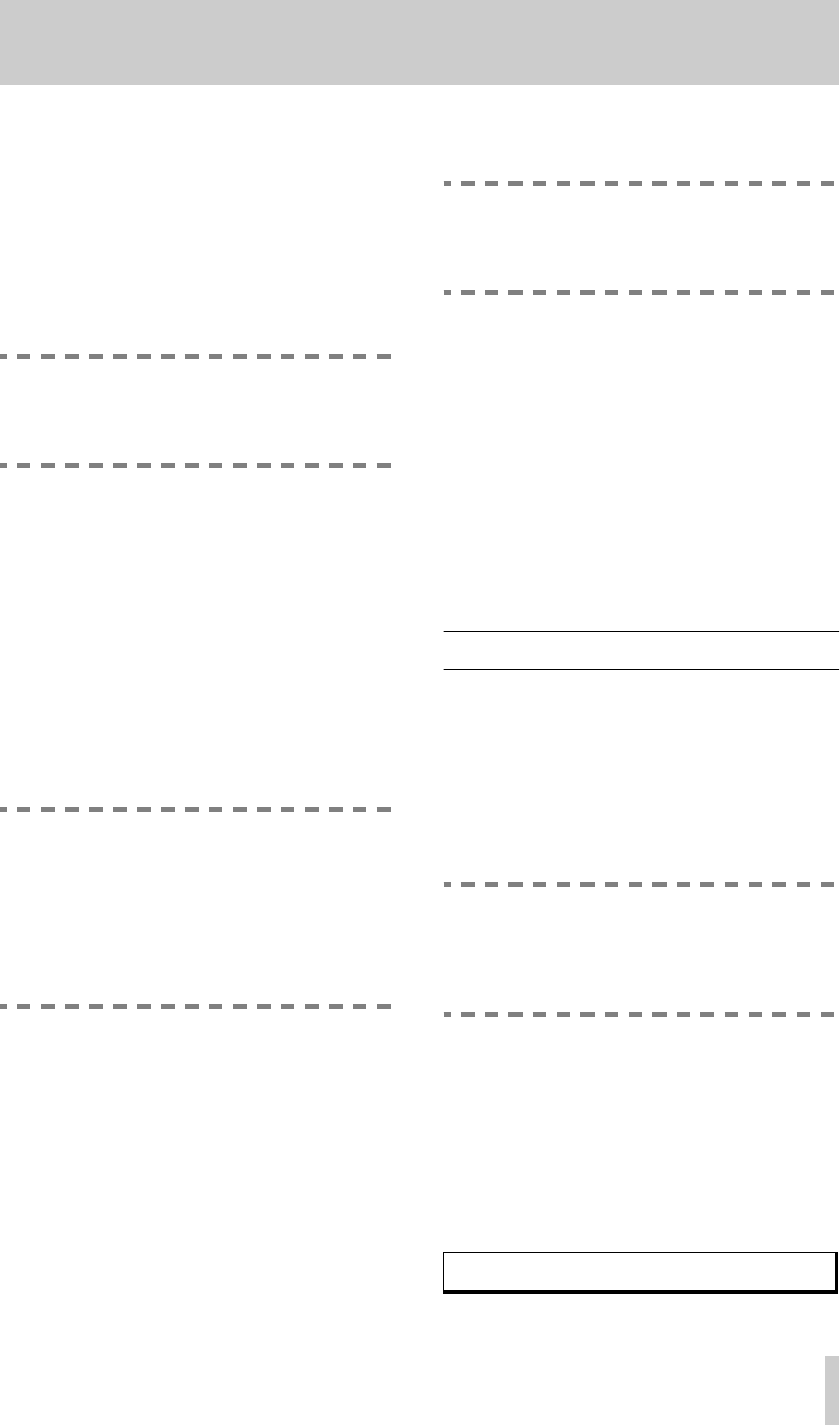
2 - Parts of the tape deck
TASCAM DA-40
11
[5] Fs switch
Use this switch to select the sampling frequency
(44.1 or 48 kHz) when making analog recordings.
When making digital recordings, the sampling fre-
quency is automatically detected.
When playing back tapes that have already been
recorded, this switch has no effect. The sampling fre-
quency of a recorded tape is fixed, and cannot be
changed.
NOTE
When making long play recordings, settings
made with this switch have no effect. The
sampling frequency is fixed at 32 kHz.
[6] INPUT selector switch
The left (
UNBAL
) and center (
BAL
) positions of
this switch allow the selection between the unbal-
anced RCA jacks or the balanced XLR jacks
respectively.
The right (
DIGITAL
) position allows the selection of
the digital input jacks.
[7] DIGITAL INPUT selector switch
When the
INPUT
switch
[6]
is set to the
DIGITAL
position, this switch is used to choose between the
RCA
COAXIAL
and the XLR
AES/EBU
digital
audio input sources.
NOTE
Despite the name of the switch setting and
the connectors (
AES/EBU
), the XLR connec-
tors are capable of receiving SPDIF format
input, and the RCA
COAXIAL
connectors are
capable of receiving AES/EBU format. The
tape deck will automatically detect the input
format and adjust itself accordingly.
[8] ANALOG INPUT selector switch
When the
INPUT
switch
[6]
is set to
ANALOG
, this
switch is used to select between
UNCAL
and
CAL
.
UNCAL
means that the analog signal source works
at an uncalibrated nominal level which is neither
+4 dBu nor –10 dV, requiring the use of the input
level controls to adjust the recording level.
The
CAL
position is for use with analog sources
which are calibrated to use either the standard
+4 dBu or the –10 dBV level as a nominal level. The
input level controls are not used in this case.
NOTE
If this switch is set to the
CAL
position, make
sure that no parts of the program material will
cause clipping.
[9] INPUT level controls
When recording from analog sources with the
ANALOG INPUT
switch
[8]
set to
UNCAL
, these
controls adjust the level of the input signal to the left
and right tape tracks.
They have no effect when the switch is set to the
CAL
position, or when recording from a digital
audio source.
[10]PHONES control and jack
Any standard pair of stereo headphones may be
plugged into this 1/
4
-inch jack, and the level adjusted
with the rotary control.
2.3 Tape controls
The following keys provide control of the tape trans-
port, recording modes, etc. Please read this section
carefully if you are not sure of transport operations
using the tape deck.
[11]SKIP keys
These keys are used to move the tape forward or
backward by a certain number of programs.
NOTE
A “program” on a DAT cassette starts with a
START ID marker. The audio portion of the
data recorded on a DAT cassette is not used
to determine the division into tracks.
Repeated presses of these keys will move the tape
forwards or backwards by the appropriate number of
programs (pressing the skip forward key once will
move the tape to the beginning of the next program,
etc.).
While the tape is locating, the display will show
(flashing on the right) the number of programs which
must still be passed, and (on the left) the current pro-
gram number:
PNO
ABS
00
H
12
M
46
S
08+02


















